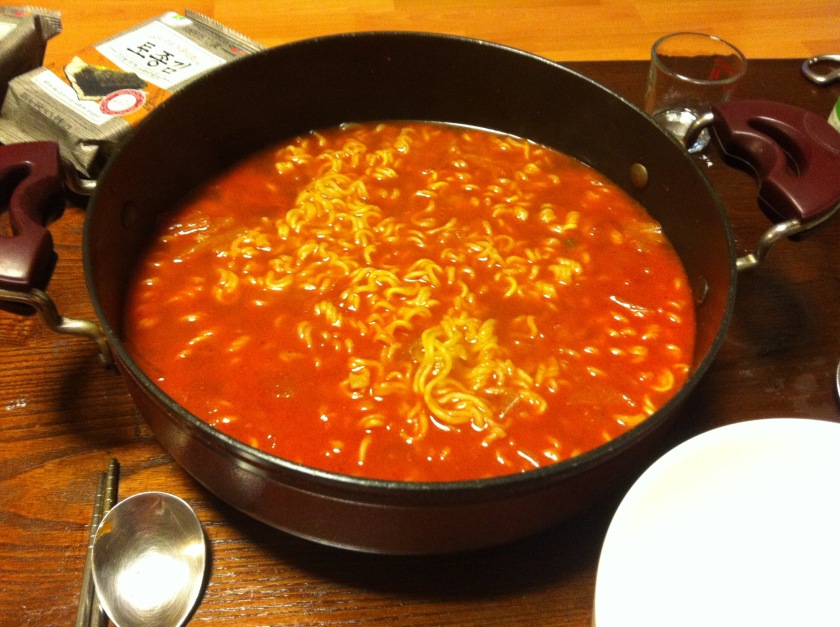What does anju mean? Anju is food to eat while drinking alcohol.
Among the many special features of Korean drinking culture–peer pressure to rival the wildest fraternity, the highest rate of liquor consumption in the world, its centrality to success at work, the acceptability of coming to work hungover–is the taboo against drinking without eating.

Going to the second place (이차) on a work outing? Stuffed after an hour or more eating wave upon wave of grilled pork belly (삼겹살)? Doesn’t matter–you’re still ordering some fried chicken or a fruit plate.
Think that $5 (W6,000) all-you-can-drink river of makkŏlli looks great? Better check on the food menu, cause you’re gonna have to order at least one $15+ plate of food–anju is also how a lot of establishments make the real money.
Origin
Anju is a Sino-Korean word. The Classical Chinese characters are 按酒–literally, to block or keep down + alcohol.
Context: Types of anju
Almost anything can be anju, and there is so much drinking going on in Korea that there are many, many foods that would be readily recognized as such. Many are commonly paired with a particular type of drink. Here are a few examples–if you want to read more, and have enough Korean, check out this web comic (manhwa 만화).
With beer
Grilled lamb skewers (yangkkoch’i 양꼬치): Lamb in general hasn’t enjoyed much popularity in Korea, but these days, lamb skewers have become a new anju trend, especially in Chinese restaurants equipped with special tables for grilling them. They’re served with Tsingtao beer and sometimes baijiu, a rather distinctive-tasting Chinese liquor.

Fried stuffed peppers (koch’ut’wikim / gochutwigim 고추튀김):
At Hanchanŭi Ch’uŏk (한잔의 추억, Memory of a Drink), or HanChu, in Gangnam, fried peppers stuffed with beef are a treat with cold lager.

Dried fish, squid and meat (chwip’o 쥐포, ochingŏ 오징어, yukp’o 육포): Dried protein is often served as anju. The picture above I took at a big drinking house in Gangnam after the wedding reception of a friend, but it’s also popular to have this kind of anju while drinking on the plastic chairs outside convenience stores, which often sell it. Salted peanuts or other nuts are also eaten in this context.

Chicken (치킨): This could be considered a meal on its own, really, but when I asked my husband about his favorite anju, this was at the top of his list. Usually eaten with beer in the ch’imaek context.

Pizza (피자): As craft beer (suchemaekchu 수제맥주) has taken off in Korea over the past few years, pizza has become a popular anju to go along with it. As wiki.namu notes, pizza goes especially well with ale-style beers.
With makkŏlli

Tofu and kimchi (tupukimch’i 두부김치): This dish of warm kimchi stir-fried with pork and served with a firm tofu is often served with makkŏlli (막걸리), a cloudy white, traditional Korean drink often called a rice wine in English. This photo is from Damotori 다모토리 in Seoul.

Savory pancake (chŏn 전): Kimchichŏn and haemulp’achŏn are probably the most common of the many types of chŏn, all of which are delicious with makkŏlli. This is pomnamulchŏn (봄나물전), savory pancake with spring greens, at 이파리 in Seoul.
With soju
Maeuntang (매운탕): Anju for soju are often spicy, fatty or both. Maeuntang, a very spicy seafood soup, falls into the spicy category.

Hagfish (kkomchangŏ 꼼장어): Possibly the worst-named aquatic animal in English, the hagfish is an eel-like creature whose flavor I frankly do not appreciate–but we tried it stir-fried as anju in this pojangmacha (포장마차) on a wintry trip to Yeosu. Similar spicy stir-fries are also often served with soju.

Intestines (gopchang 곱창): Gopchang, the intestines of pork or beef, is usually stir-fried or grilled, sometimes with a spicy sauce. As with many types of food, gopchang can be found throughout Seoul, but there’s still a specialty district–in this case, the area around Wangsimni Station (왕십리역), which is where I first tried it. Some love ’em, some hate ’em, but with offal coming back into vogue in many places, gopchang is worth a try.

Ramyeon (ramyŏn 라면): Some people, including my husband, think ramyeon makes an excellent anju for soju. He made this batch on a poorly-timed trip to Jeju-do, when we were stuck in our hotel during a tropical cyclone.
Sources
Personal experience.
Resident Korean food and drink expert, aka my husband.
“술안주.” 나무위키. 2016년4월14일. Web. 2016년5월9일.
“안주.” 다음 국어 사전. n.d. Web. 2016년5월10일.
“酒.” 다음 한자 사전. n.d. Web. 2016년5월10일.
“按.” 다음 한자 사전. n.d. Web. 2016년5월10일.

These photos look so familiar with me! 😀
LikeLike
Haha! Actually, I think you can see your arm and coat in the pizza and ale one! 😉 I cropped out your face^^
LikeLike
Hi there – I’m James Conner’s Korean/Gyopo brother-in-law in Vancouver and I found this post very helpful for a presentation we’re organizing here about Korean drinking culture. Thanks much!!
LikeLike
Wow awesome!! I’m so glad James shared it and it was helpful^^
LikeLike